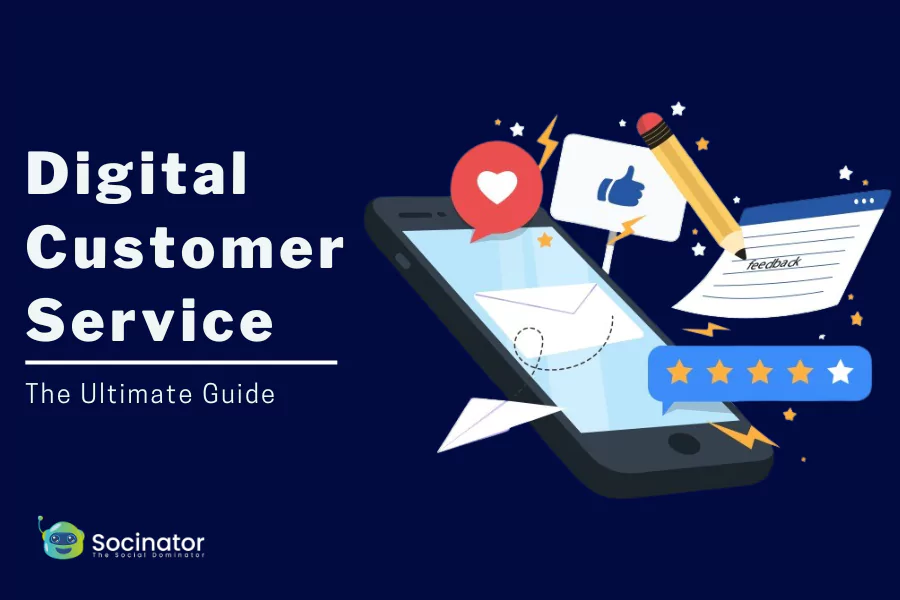In an environment where fast and effective support matters, businesses are rethinking customer interactions. Digital customer service is no longer an option—it’s essential. Customers expect quick, seamless, and personalized experiences, and companies that deliver stand out.
Every interaction is a chance to build trust and loyalty. Traditional service methods are giving way to smarter, tech-driven solutions that improve response times and enhance customer satisfaction. Whether it’s AI chatbots, self-service portals, or real-time support, digital tools help businesses stay ahead.
But great customer service isn’t just about technology—it’s about strategy. To succeed, companies must optimize workflows, train teams, and use data-driven insights to refine their approach. The right tools and processes can turn customer support into a competitive advantage.
This blog will walk you through everything you need to know about digital customer service in 2025. From choosing the best platforms to streamlining operations, you’ll learn how to create an experience that keeps customers coming back. Let’s get started.
Listen To The Podcast Now!
The Evolution Of Customer Service Strategy
 The transformation from traditional to digital customer service has been gradual yet profound. In the past, customer service was defined by face-to-face interactions, telephone support, and printed communications. Although these methods have served well for many years, they often fell short in speed, scalability, and personalization.
The transformation from traditional to digital customer service has been gradual yet profound. In the past, customer service was defined by face-to-face interactions, telephone support, and printed communications. Although these methods have served well for many years, they often fell short in speed, scalability, and personalization.
With the rise of the internet and mobile technology, businesses began to shift their focus. Digital customer service emerged as a natural progression to meet customer expectations. Today, customers expect their issues to be resolved within minutes and for service representatives to have a deep understanding of their history and needs.
This evolution required companies to reimagine their customer service strategy. No longer is it sufficient to have reactive support channels; businesses must now adopt a proactive approach that anticipates issues and resolves them efficiently. The transition to digital customer service is supported by modern tools and practices that redefine how support is delivered.
By integrating digital customer service into your operations, you are not only addressing current needs but also setting the stage for a dynamic customer service strategy that evolves with technological advances. Digital tools have reshaped customer service strategy by automating routine interactions, analyzing customer behavior, and facilitating personalized engagement. This evolution makes it clear that a modern customer service strategy must be data-driven, agile, and customer-centric.
Master Digital Experience Management
 Digital experience management refers to overseeing and enhancing every interaction that customers have with your brand across digital channels. It includes everything from website navigation and mobile app usability to the responsiveness of live chat support.
Digital experience management refers to overseeing and enhancing every interaction that customers have with your brand across digital channels. It includes everything from website navigation and mobile app usability to the responsiveness of live chat support.
Effective digital experience management is essential for maintaining high standards in digital customer service. By ensuring that every digital touchpoint is optimized for ease of use and responsiveness, companies can greatly improve digital customer experiences. Benefits include increased customer satisfaction, reduced frustration, and higher engagement rates. When customers have a seamless journey, they are more likely to return and recommend your brand to others.
Strategies for managing digital customer experiences involve a combination of technology and best practices. It can include regular audits of your digital interfaces, user testing, and feedback collection. By continuously monitoring these areas, you can identify pain points and implement improvements. Furthermore, a dedicated focus on digital experience management allows you to track changes over time, making it easier to measure the impact of your enhancements.
Investing in digital experience management not only boosts the immediate quality of customer interactions but also contributes to a sustainable, long-term customer service strategy. Through this holistic approach, businesses can ensure that every customer interaction is positive and reinforces your commitment to quality service.
Leverage Digital Experience Analytics
 Digital experience analytics is the systematic process of collecting and interpreting data related to customer interactions. This data provides insights into what is working well and what areas need improvement. In a landscape where every click and message counts, digital experience analytics empowers businesses to fine-tune their digital customer service.
Digital experience analytics is the systematic process of collecting and interpreting data related to customer interactions. This data provides insights into what is working well and what areas need improvement. In a landscape where every click and message counts, digital experience analytics empowers businesses to fine-tune their digital customer service.
Analytics play a critical role in customer satisfaction. By measuring key performance indicators—such as response times, resolution rates, and customer feedback—companies can gain a comprehensive view of how well their digital service is performing. With these insights, businesses can adjust their approach to address any gaps in the customer experience.
Data-driven insights from digital experience analytics allow companies to make informed decisions. For instance, if analytics indicate that response times are lagging during peak hours, additional resources can be allocated to ensure faster service. Moreover, digital experience analytics can reveal customer trends, preferences, and behavior patterns, which are invaluable for planning future enhancements.
By integrating digital experience analytics into your operations, you ensure that every element of your digital customer service is continuously improved. These insights provide a clear roadmap for optimizing processes and ensuring service remains responsive and relevant. Ultimately, leveraging digital experience analytics transforms digital customer service into a proactive discipline where every interaction is guided by data.
Transform Digital Customer Experiences
 Creating a seamless digital customer experience requires more than just responding to customer queries—crafting a journey that is intuitive, engaging, and reflective of your brand’s values. A well-structured digital experience fosters trust, enhances customer satisfaction, and strengthens long-term relationships.
Creating a seamless digital customer experience requires more than just responding to customer queries—crafting a journey that is intuitive, engaging, and reflective of your brand’s values. A well-structured digital experience fosters trust, enhances customer satisfaction, and strengthens long-term relationships.
Key elements of an effective digital customer experience include personalization, ease of navigation, timely responses, and a customer-centric approach. Personalization, in particular, plays a crucial role in making interactions meaningful. By leveraging customer data, businesses can tailor responses based on past interactions, preferences, and behaviors—making customers feel valued and understood.
Best Practices for Enhancing Digital Interactions
Improving digital customer experiences starts with a deep understanding of your audience. Segmenting customers based on their needs and behaviors enables businesses to provide more relevant and engaging interactions. For instance, using AI-driven chatbots for instant responses while ensuring human support is available for complex queries creates a balanced, efficient service model.
Customer feedback is another essential pillar of transformation. Actively collecting and analyzing feedback helps businesses identify pain points and make necessary improvements. Whether through surveys, real-time chat analytics, or social media sentiment analysis, integrating customer insights ensures a proactive approach to service enhancement.
By continually refining digital interactions, brands create a service ecosystem that not only meets but exceeds customer expectations. Every positive interaction contributes to a cycle of improvement, leading to increased customer loyalty and advocacy.
As businesses look for ways to optimize their digital customer service, leveraging automation and advanced social media tools becomes essential. It is where theSocinator steps in. Socinator enables brands to enhance their digital customer experiences effortlessly, by automating engagement, monitoring customer sentiment across social platforms, and providing data-driven insights.
With its comprehensive features, businesses can ensure timely responses, manage interactions efficiently, and maintain a strong online presence—ultimately driving better engagement and customer satisfaction.
Socinator: Enhance Digital Customer Service With Smart Automation
 Socinator is a powerful automation and marketing tool designed to help businesses efficiently manage customer interactions across multiple digital platforms. By streamlining engagement, monitoring conversations, and automating responses, Socinator plays a vital role in optimizing digital customer service without compromising the human touch.
Socinator is a powerful automation and marketing tool designed to help businesses efficiently manage customer interactions across multiple digital platforms. By streamlining engagement, monitoring conversations, and automating responses, Socinator plays a vital role in optimizing digital customer service without compromising the human touch.
Key Features of Socinator for Digital Customer Service
- Automated Posting – Schedule and automate tweets, images, and videos to maintain a consistent social media presence without manual effort.
- Auto-Follow and Unfollow – Grow your audience strategically by automatically following and unfollowing users based on specific criteria, boosting engagement.
- Auto-Like and Comment – Increase visibility and interaction by automating likes and comments on relevant content, ensuring continuous engagement with your audience.
- Social Media Analytics – Track key performance metrics, including follower growth and engagement rates, to optimize your Twitter management strategy.
- Proxy Support – Protect your social media accounts by using proxies, reducing the risk of restrictions and ensuring uninterrupted automation.
By incorporating Socinator into your digital service approach, businesses can improve efficiency, maintain consistency, and enhance the overall customer experience. In a real-world scenario, companies using Socinator have successfully reduced response times, strengthened customer relationships, and improved satisfaction scores by automating repetitive tasks while keeping human agents available for complex queries.
Effective Social Media Monitoring For Digital Customer Service
 Social media has become a critical space for customer interactions, requiring businesses to stay responsive and engaged. Customers now expect quick resolutions on platforms like Facebook, Twitter, and Instagram, making social media monitoring essential for delivering high-quality digital customer service.
Social media has become a critical space for customer interactions, requiring businesses to stay responsive and engaged. Customers now expect quick resolutions on platforms like Facebook, Twitter, and Instagram, making social media monitoring essential for delivering high-quality digital customer service.
The Role Of A Social Media Monitoring Tool
A social media monitoring tool helps businesses track brand mentions, comments, and direct messages across platforms in real-time. Beyond responding to queries, these tools enable businesses to:
- Identify and address issues before they escalate.
- Engage with customers at the right moment to build stronger relationships.
- Gain insights into customer sentiment and expectations.
- Track trends that shape future customer service strategies.
By proactively managing customer conversations, brands can enhance their digital customer experiences and maintain a strong reputation.
Best Practices for Social Media Monitoring
To maximize the impact of social media monitoring, businesses should:
- Set Up Smart Alerts – Track brand-related keywords, product mentions, and common service issues to ensure no critical conversation is missed.
- Prioritize Urgent Inquiries – Distinguish between general mentions and pressing customer concerns to optimize response times.
- Analyze Customer Sentiment – Use analytics to assess feedback tone, allowing for better decision-making in engagement strategies.
- Monitor Indirect Mentions – Customers often discuss brands without tagging them directly. Identifying these conversations allows for proactive engagement.
- Maintain Consistent and Professional Responses – A standardized yet personalized approach ensures clarity and strengthens brand credibility.
With a well-structured monitoring approach, businesses can move beyond reactive support and create meaningful interactions that enhance digital customer experiences.
Integrate Digital Experience Management With Social Media Monitoring
 The fusion of digital experience management with social media monitoring tools creates a seamless and data-driven approach to digital customer service. Instead of treating these as separate functions, integrating them allows businesses to build a holistic strategy that improves customer engagement, responsiveness, and satisfaction.
The fusion of digital experience management with social media monitoring tools creates a seamless and data-driven approach to digital customer service. Instead of treating these as separate functions, integrating them allows businesses to build a holistic strategy that improves customer engagement, responsiveness, and satisfaction.
The Impact of Integration on Digital Customer Service
Bringing together digital experience management and social media monitoring gives businesses a comprehensive view of customer interactions. This synergy ensures consistency across all touchpoints—whether customers engage through a website, chat support, or social media—while leveraging real-time insights for improved service.
For instance, social media monitoring tools track brand mentions, customer sentiment, and direct inquiries across platforms. When combined with a digital experience management system, businesses can:
- Spot Emerging Trends – Analyze customer feedback to detect patterns and proactively address potential issues.
- Enhance Personalization – Deliver tailored responses based on past interactions, strengthening customer relationships.
- Refine Response Strategies – Align social media engagement with the brand’s overall communication approach.
- Boost Customer Satisfaction – Create a seamless experience by ensuring real-time, cross-channel engagement.
By integrating these tools, businesses can optimize their customer service efforts, making interactions more efficient, responsive, and customer-focused.
Data-Driven Decisions for Improved Customer Experience
By integrating social media analytics with digital experience management, businesses can make data-driven decisions to enhance digital customer experiences. Metrics such as customer sentiment, engagement rates, and response times become valuable indicators of customer satisfaction.
For instance, if a particular product receives repeated complaints on social media, businesses can use this data to refine their service approach, update FAQs, or even improve the product. Similarly, social media monitoring can help brands identify and amplify positive customer experiences, strengthening brand loyalty.
Real-World Success Through Integration
Many companies have successfully integrated digital experience management with social media monitoring tools, leading to tangible improvements in efficiency and customer satisfaction. Businesses that adopt this approach report:
- Faster response times and more effective issue resolution.
- Higher engagement rates due to proactive customer interactions.
- Improved consistency across multiple digital platforms.
- Better alignment between social media teams and customer support teams.
A well-integrated system ensures that every customer interaction—whether on a company website, a chatbot, or a social media comment—contributes to a unified customer service strategy. This approach not only enhances digital customer experiences but also sets the foundation for long-term customer loyalty and business growth.
Future Trends In Digital Customer Service
 As technology continues to advance, the future of digital service promises to be both dynamic and transformative. Predictions suggest that artificial intelligence, machine learning, and advanced automation will play increasingly significant roles. These emerging technologies are expected to refine the balance between automated and personalized support, ensuring that customer inquiries are resolved more efficiently than ever before.
As technology continues to advance, the future of digital service promises to be both dynamic and transformative. Predictions suggest that artificial intelligence, machine learning, and advanced automation will play increasingly significant roles. These emerging technologies are expected to refine the balance between automated and personalized support, ensuring that customer inquiries are resolved more efficiently than ever before.
One major trend is the enhanced integration of digital experience analytics into everyday customer service operations. As analytics become more sophisticated, businesses will have access to deeper insights that enable them to predict customer behavior and adapt their services accordingly. This data-driven approach will ensure that digital customer service remains relevant and highly effective.
Another trend is the growing importance of omnichannel support, where customers experience a seamless transition between various platforms without any disruption in service quality. As more companies adopt integrated systems, the ability to provide a consistent and responsive digital customer service experience will become a key differentiator.
Businesses that stay ahead in digital service will continuously invest in technology, training, and strategic planning. By keeping an eye on emerging trends and adapting to new tools, companies can maintain a competitive edge and ensure that their digital service remains robust and responsive.
Also Read,
How To Master Social Media Customer Service
5 Amazing Social Media Customer Service Templates For 2024
How To Build A Smarter Martech Stack With Social Data?
Conclusion
Delivering exceptional digital customer service requires a proactive, data-driven approach. By leveraging digital experience management, analytics, automation, and social media monitoring, businesses can enhance customer interactions, improve response times, and foster long-term loyalty.
Tools like Socinator make it easier to streamline engagement, track customer sentiment, and maintain a strong online presence—ensuring that every digital touchpoint is optimized for success. As technology continues to evolve, staying ahead in digital customer service means continuously refining strategies and embracing innovative solutions.
By integrating these best practices, brands can create seamless, meaningful digital experiences that not only meet customer expectations but exceed them—building lasting relationships and a strong reputation in the process.
Frequently Asked Questions (FAQ)
- How can small businesses implement digital customer service effectively?
Small businesses can implement digital customer service by leveraging cost-effective tools such as chatbots, automated email responses, and social media messaging. Prioritizing a user-friendly website, prompt responses, and personalized interactions can significantly improve the customer experience without requiring a large budget. - What are the biggest challenges businesses face when transitioning to digital service?
The most common challenges include integrating new technologies with existing systems, training employees to adapt to digital platforms, ensuring fast response times, and maintaining a balance between automation and human interaction. Overcoming these challenges requires a clear strategy, the right tools, and ongoing monitoring. - How can businesses maintain a personal touch while using automation?
Businesses can personalize automated interactions by using customer names, referencing past interactions, and ensuring that human support is available when needed. AI-driven chatbots with natural language processing can also provide a more conversational experience, making interactions feel less robotic. - How does digital service impact brand reputation?
Digital service directly influences brand reputation by shaping customer perceptions. Prompt and effective responses, transparent communication, and proactive problem-solving can enhance customer trust and loyalty. On the other hand, slow or impersonal service can lead to negative reviews and lost business. - What are the key performance indicators (KPIs) to measure the success of digital service?
Key KPIs include response time, resolution time, customer satisfaction (CSAT) scores, Net Promoter Score (NPS), and customer retention rates. Analyzing these metrics helps businesses identify areas for improvement and refine their digital service strategy.






